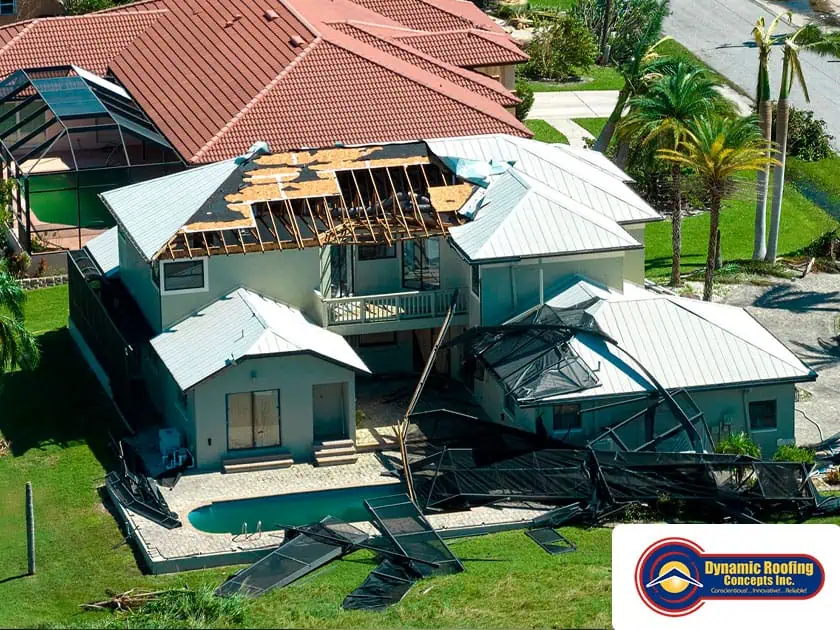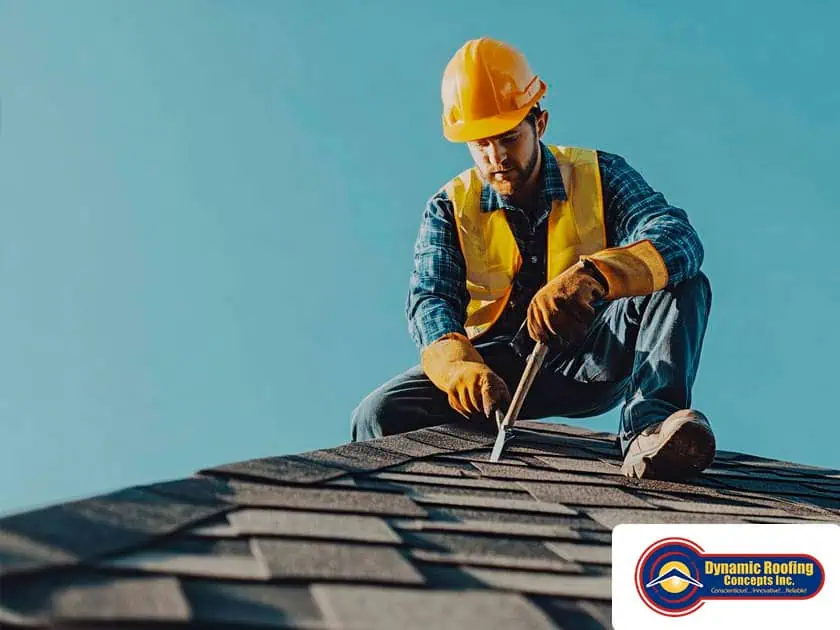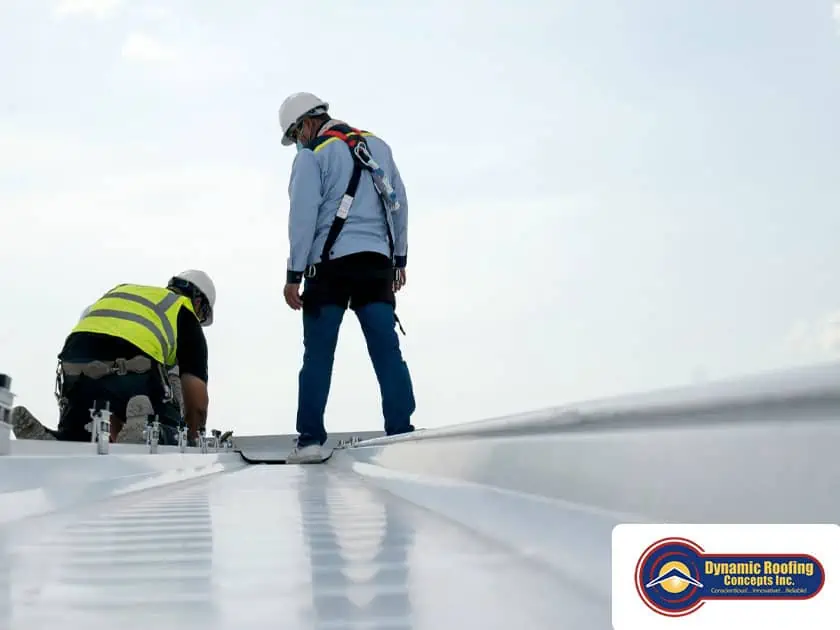

Share On:
Hurricane season runs from
June 1 to November 30, bringing high winds, heavy rain, and flying debris that can severely damage roofs. Preparing your roof for hurricane season now reduces the risk of costly repairs and helps protect your home from storm-related damage.Rather than waiting for a last-minute storm warning, hurricane-proofing your roof in advance strengthens weak spots, prevents water intrusion, and increases your home's overall resilience.
📞
Schedule a Free Roof Inspection with Dynamic Roofing Concepts before the first storm hits!Hurricane-Proof Roof: Weak Spots to Fix Before Storm Season
Severe weather conditions, including hurricane-force winds and intense rain, can quickly expose vulnerabilities in a roof. Here are some of the most common weaknesses that can lead to damage:
Loose or Missing Shingles
High winds can lift poorly sealed, aging, or damaged shingles, exposing your roof decking and underlayment to water infiltration. Shingles with curled edges or missing granules are particularly vulnerable. Whether you have asphalt shingles, slate, clay, or tile roofing, proper maintenance and timely replacements help prevent wind damage. If your roof is over 10 years old, consider a professional assessment to determine its durability against extreme weather.
If your shingles are missing or deteriorating, check out this guide on
what to do about missing shingles in Tampa.Weak Flashing or Seals
Flashing prevents water from seeping into gaps around chimneys, skylights, and vents. However, over time, exposure to Florida’s extreme weather, including heavy rain, high wind speeds, and salt air, can cause corrosion in metal flashing, especially if not made of stainless steel or copper. During a tropical cyclone or hurricane making landfall, loose flashing can detach, exposing the roof structure. This can lead to water damage, mold growth, and costly repairs. The Federal Emergency Management Agency (FEMA) recommends reinforced bitumen waterproofing for added durability. Upgrading to hurricane-rated flashing materials and following Florida building codes helps improve storm resistance.
Clogged Gutters & Drainage Issues
A well-functioning gutter system directs water away from the roof and home foundation. However, clogged gutters can cause water to back up and overflow, leading to leaks and structural damage. Poor drainage can also result in standing water that weakens the roofing materials and promotes wood rot in roof decking. Regular cleaning and installing high-capacity downspouts can prevent water buildup and costly repairs.
Aging or Damaged Roof Decking
Your roof’s decking serves as the foundation for your shingles and other roofing materials. If the decking is weak due to age, moisture damage, or previous leaks, it becomes more susceptible to wind uplift and impact from flying debris. Reinforcing the decking with additional fasteners and sealing any weak areas can enhance storm resistance. Upgrading to hurricane-rated roofing materials can provide additional strength and durability.
Learn more about
how to determine the age of your roof and whether it's time for reinforcement.Flat Roofs & Ponding Water Risks
Homes with flat roofs face unique challenges during hurricane season. Without proper drainage, water can collect and exert excessive pressure on the roof membrane, leading to leaks or even structural failure. Regular maintenance, proper sloping, and reinforced waterproofing help prevent issues associated with ponding water. Consider installing a tapered insulation system to enhance drainage.
Steps to Strengthen Your Roof Before Storm Season
1. Schedule a Professional Roof Inspection
A certified roofer can identify potential weaknesses that may not be visible from the ground. Inspections help detect loose shingles, soft spots, damaged flashing, and other risks.
Book a Roof Inspection!2. Secure Loose Shingles & Roof Materials
Replacing missing or curled shingles prevents wind uplift. Upgrading to impact-resistant roofing, such as a metal roof or GAF hurricane-rated shingles, provides better storm resistance and longevity. Investing in architectural shingles with superior adhesion can further reduce wind damage.
3. Reinforce Roof Flashing & Seals
Check and reinforce flashing around chimneys, vents, skylights, and gable roofs. Loose flashing can detach in strong winds, leading to water intrusion. For added protection, consider using bitumen-based waterproofing and hurricane-rated stainless steel flashing. Applying a weatherproof sealant like NP1 or Vulkem 116 enhances durability against hurricane-force winds and prevents corrosion. Flashing deterioration is a major cause of leaks. Learn about fascia boards and their role in waterproofing.
4. Clean & Secure Gutters for Proper Drainage
Remove leaves, branches, and debris to ensure water flows freely away from your roof. Inspect for loose, sagging, or damaged gutters that could detach in high winds. Consider installing gutter guards to reduce future blockages. Ensuring proper slope in your gutters can prevent overflow and ice dam formation during winter storms.
Related Blog: How Gutters Protect Your Roof
5. Trim Overhanging Trees
Overhanging tree branches can snap under the force of hurricane winds, becoming dangerous projectiles. Hiring a professional to trim trees around your home minimizes this risk and reduces the chances of branches puncturing your roof. Regular tree maintenance also helps prevent mold and algae growth caused by excessive shade and moisture retention.
6. Consider Storm-Resistant Roofing Options
If your roof is nearing the end of its lifespan, investing in a storm-resistant roofing system can save money in the long run. Options include:
| Roofing Type | Wind Speed Resistance | Durability | Cost | Maintenance Needs |
| Metal Roof (Steel or Copper) | 140-180 mph | 40-70 years | $$$ | Low |
| Clay & Concrete Roof Tiles | 125-150 mph | 50+ years | $$$$ | Moderate |
| Impact-Resistant Asphalt Shingles | 110-130 mph | 30-50 years | $$ | Low |
| Slate Roofing | 160+ mph | 75+ years | $$$$$ | High |
Metal Roofs: Resistant to corrosion, fire, and Atlantic hurricane conditions, ideal for coastal areas. Known for their durability and wind resistance. If you're considering an upgrade, read: is a standing seam metal roof worth it?- Clay & Concrete Roof Tiles: Heavy but durable, providing excellent hurricane resistance when properly fastened. Heavy and durable, but proper installation is critical. Learn about how long a tile roof lasts in Florida.
- Impact-Resistant Asphalt Shingles: Budget-friendly and wind-resistant, reducing insurance deductibles. Designed to handle hail and wind uplift. Compare options in 3-tab vs. architectural shingles.
- Slate Roofing: Toughness and longevity make it a premium option, though heavier and requiring additional roof pitch support.

The Role of Insurance & Roof Documentation
Before a storm arrives, document your roof’s current condition. Taking photos and obtaining a professional inspection report can be invaluable when filing a home insurance claim. Insurers may deny claims for pre-existing issues, so regular maintenance is critical. Keeping a record of repairs and upgrades can also help ensure full coverage. Working with a roofing contractor who provides detailed inspection reports can streamline the claims process.
Related Blog: Does Home Insurance Cover Roof Repair
What to Do If Your Roof Suffers Hurricane Damage
After a storm, follow these emergency management steps:
- Inspect the roof for visible damage, including missing asphalt shingles, cracked slate, loose tile, or exposed plywood decking.
- Photograph the damage immediately—this is critical for your insurance policy and deductible calculations.
- Contact your home insurance provider and file a claim with the National Flood Insurance Program (NFIP) if flooding has occurred. Understand the insurance claim process by reading how to negotiate a roof replacement with insurance.
- Use a temporary waterproofing solution, such as bitumen tarps, until professional repairs are made. Learn the best emergency roof repair techniques from our roof repair tips.
- Check your mortgage or home loan agreement, as some lenders require storm damage repairs to be reported. Find out if your home insurance covers roof repair by reading does home insurance cover roof repair?
- Hire a licensed Florida roofer to assess structural damage, including truss integrity, rafter stability, and ridge alignment.
Not sure if you should DIY or call a pro? Find out why you shouldn't DIY roof repairs.
Why Work with a Professional for Hurricane Roof Prep?
Not all roofing contractors are equipped to handle hurricane-proofing homes. Here’s why choosing an experienced professional matters:
- Local Experience Matters: With over 20 years of experience in Brandon, FL, Dynamic Roofing Concepts understands the unique risks posed by the Atlantic hurricane season and how to mitigate them effectively.
- Storm-Resistant Roofing Solutions: As a GAF Master Elite Contractor, we offer hurricane-resistant roofing solutions, including metal roofing, impact-resistant shingles, and reinforced roof designs that comply with Florida building codes.
- Insurance-Friendly Roof Reports: A well-documented roof inspection provides essential information for home insurance claims, ensuring your policy covers necessary repairs or replacements.
- Fast & Reliable Repairs: When severe weather strikes, immediate repairs prevent further water damage, mold growth, and structural weakening.
- Proven Reputation: Dynamic Roofing Concepts maintains an A+ rating with the Better Business Bureau (BBB) and has earned strong customer reviews for reliability and workmanship.
📞 For expert hurricane roof preparation, call (813) 657-7663 or schedule a free roof inspection!
Get Your Roof Ready Before Hurricane Season
Regular maintenance and timely inspections can save homeowners thousands of dollars in storm-related repairs. Don’t wait until a hurricane warning is issued—start preparing today. Ensuring your roof is in top condition before hurricane season helps protect your home, family, and valuables from costly storm damage. By scheduling an inspection now, you can address potential vulnerabilities before they become expensive emergencies.
Schedule a Free Hurricane Roof Inspection - Protect Your Home Before the Next Storm! Our team is ready to provide expert assessments, reinforce weak areas, and recommend the best storm-resistant solutions for your home. Call us now or visit our website to schedule your appointment!



